Why IP-Rated Protection Matters for Your Communication Needs
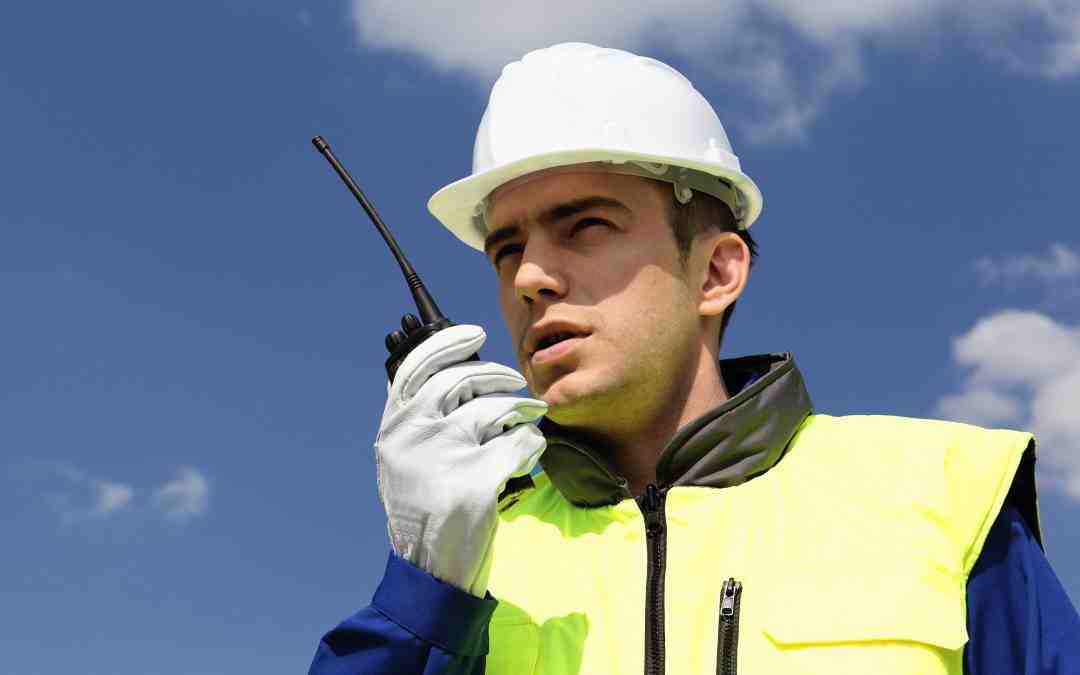
When motorola waterproof radio (ip rated) equipment fails due to water damage, teams lose critical communication exactly when they need it most. Whether you're coordinating construction crews in wet conditions, managing outdoor events, or maintaining contact during marine activities, water-resistant two-way radios keep your team connected when standard electronics would fail.
Top Motorola IP-Rated Waterproof Radios:
- IP54 Models: CP200d, CP100d, R2 - Protected against water spray and limited dust
- IP67 Models: XPR3300e, XPR3500e, EVX-S24 - Submersible up to 1 meter for 30 minutes
- IP68 Models: R7 - Submersible up to 2 meters for 2 hours
The IP (Ingress Protection) rating system tells you exactly how much water and dust your radio can handle. The first digit (0-6) covers solid particles like dust, while the second digit (0-8) measures water protection from light spray to full submersion. An IP67 rating means complete dust protection plus 1-meter submersion capability for 30 minutes.
Water damage kills more two-way radios than any other factor. Construction sites, marine environments, and outdoor activities all present moisture challenges that can destroy unprotected electronics. IP-rated radios use sealed housings, rubber gaskets, and water-displacing coatings to keep moisture out of critical components.
I'm Rene Fornaris, and with over ten years of experience in two-way radio communications, I've seen countless teams switch to motorola waterproof radio (ip rated) models after losing communication due to water damage. My background at Advanced Radio Systems has shown me which IP ratings work best for different environments and why proper waterproof protection is essential for reliable team coordination.
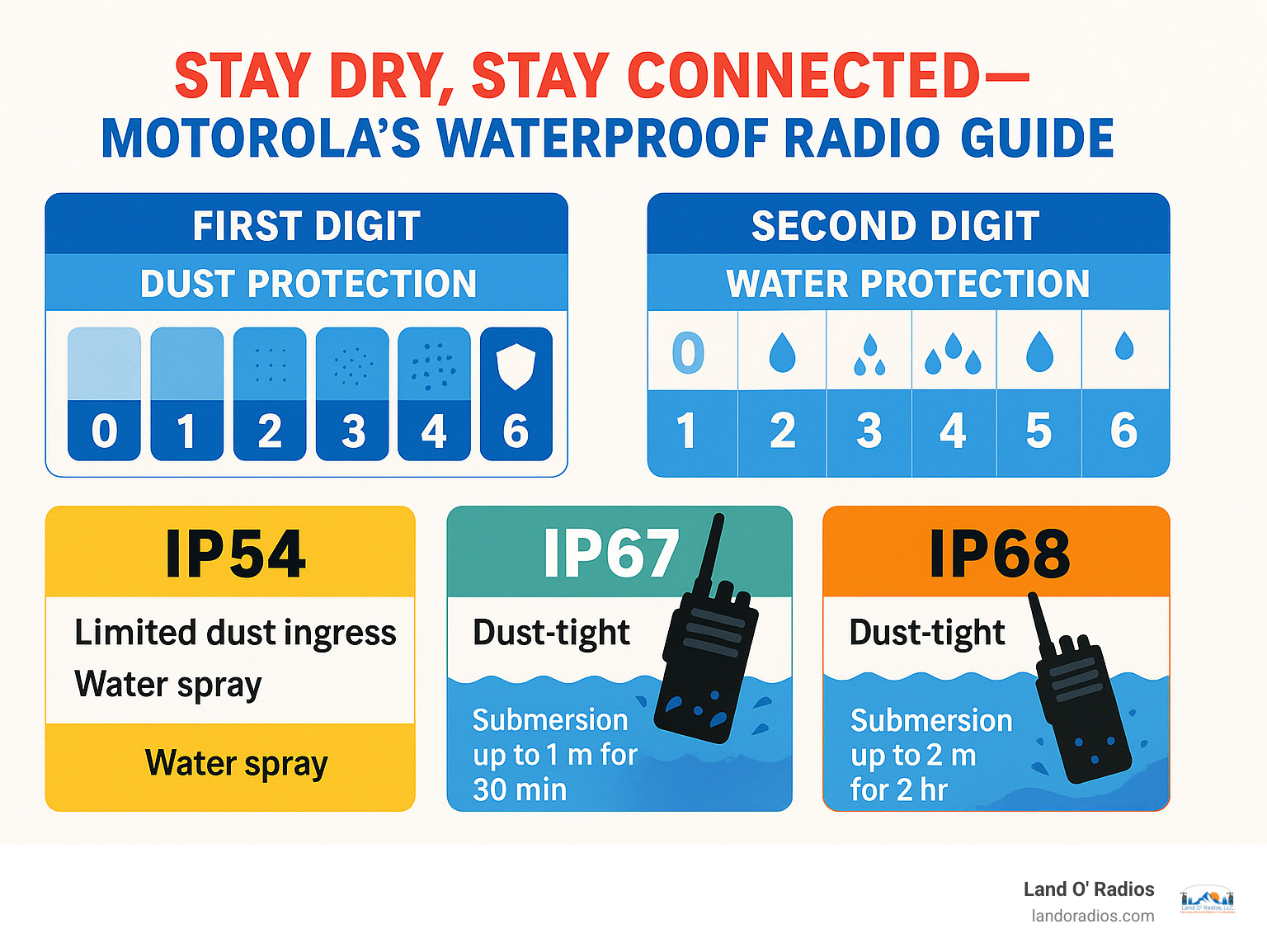
Understanding IP Ratings for Two-Way Radios
The IP rating system follows the IEC 60529 international standard, which defines how well electrical enclosures protect against dust and water ingress. When you see an IP rating like IP67 on a motorola waterproof radio (ip rated), you're looking at laboratory-tested protection levels that tell you exactly what conditions your radio can handle.
The first digit ranges from 0 (no protection) to 6 (completely dust-tight), while the second digit covers water protection from 0 (no protection) to 8 (submersion beyond 1 meter). These aren't marketing claims—they're standardized test results that manufacturers must verify in controlled laboratory conditions.
Military Standard 810 (MIL-STD) testing often accompanies IP ratings, adding shock, vibration, and environmental exposure requirements. Motorola radios like the R7 and XPR series undergo both IP and MIL-STD testing to ensure they perform in demanding conditions.
One critical point: IP ratings use freshwater in testing. Saltwater or chemical exposure may affect performance differently than laboratory conditions, so consider your specific environment when selecting protection levels.
| IP Rating | Dust Protection | Water Protection | Typical Use Cases |
|---|---|---|---|
| IP54 | Limited dust ingress | Water spray from any direction | Indoor/outdoor work, light weather |
| IP55 | Limited dust ingress | Water jets from any direction | Tough outdoor environments |
| IP67 | Dust-tight | 1m submersion for 30 minutes | Marine, construction, emergency use |
| IP68 | Dust-tight | 2m submersion for 2 hours | Extreme conditions, underwater work |
What an IP Rating Means for Waterproof & Dustproof Performance
The ingress protection system breaks down into two specific measurements that directly impact your radio's survival in harsh conditions. The first digit measures protection against solid particles, starting from 0 (no protection) and climbing to 6 (completely dust-tight with no particle ingress).
For the solids scale, IP54 and IP55 radios like the R2 allow limited dust ingress but prevent harmful amounts from entering. IP67 and IP68 models achieve complete dust-tight sealing, making them ideal for construction sites, manufacturing plants, and dusty outdoor environments.
The water protection scale (second digit) progresses from basic drip protection to full submersion capability. IP54 handles water spray from any direction, while IP55 withstands water jets. IP67 allows complete submersion up to 1 meter for 30 minutes, and IP68 extends that to 2 meters for 2 hours.
Test conditions matter significantly. IP67 testing involves lowering the radio into 1 meter of freshwater for exactly 30 minutes, then checking for water ingress that could affect operation. IP68 testing goes deeper and longer, simulating more extreme underwater scenarios.
Why IP67 and IP68 Matter in Motorola Waterproof Radio (IP Rated) Designs
Motorola's engineering approach to IP67 and IP68 protection goes beyond basic water resistance. These ratings represent full submersion capability, meaning your radio continues working even after complete underwater immersion. The Talkabout T600, for example, not only survives submersion but actually floats face-up for easy retrieval.
IP67 radios like the XPR3300e and XPR3500e use multiple sealing techniques: rubber gaskets around all openings, sealed speaker grilles, and water-displacing chemicals on internal components. The charging ports, antenna connections, and accessory jacks all receive special attention to prevent water ingress at connection points.
The R7's IP68 rating represents Motorola's most advanced waterproof engineering. This radio can handle 2 meters of water pressure for 2 hours, making it suitable for underwater work, flood response, and extreme marine conditions. The deeper rating requires improved sealing and stronger internal pressure resistance.
Motorola Waterproof Radio (IP Rated) Lineup & Comparison
Motorola's IP-rated radio lineup spans from budget-friendly IP54 models to professional IP68 units, each designed for specific environments and use cases. We've organized the lineup by protection level to help you match the right radio to your conditions.
Professional models like the XPR series, R7, and EVX-S24 target business applications with digital technology, longer battery life, and advanced features. These radios often include GPS tracking, encryption, and compatibility with repeater systems for extended range.
Channel capacity varies significantly across the lineup. Consumer models typically offer 22 channels with privacy codes, while professional radios can handle 1,000+ channels with complex programming options. Battery life ranges from 9 hours (T600 with NiMH) to 29 hours (R7 with high-capacity IMPRES battery).
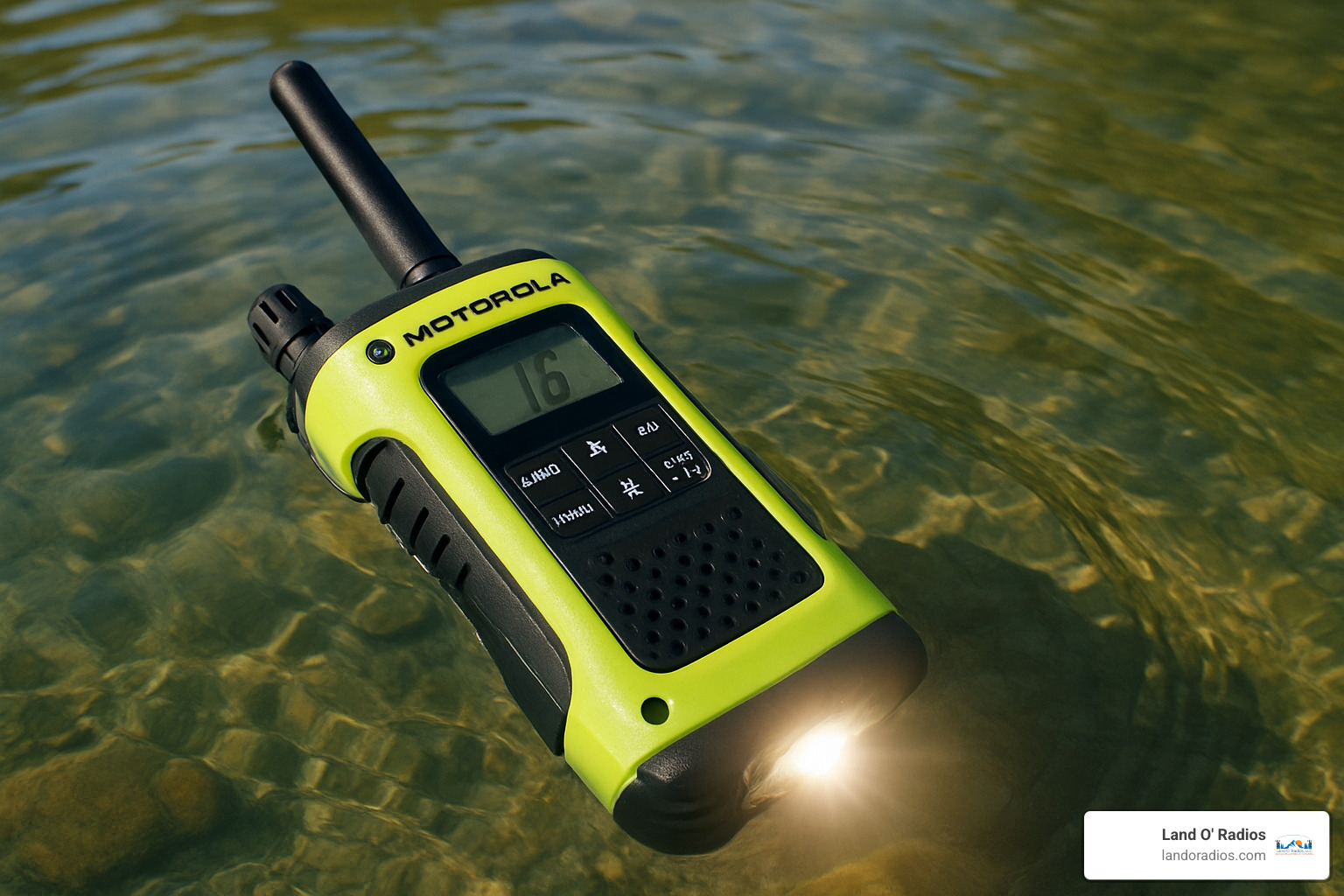
The key differentiator isn't just IP rating—it's the complete feature package. A construction crew needs different capabilities than a family camping trip, and Motorola designs each model for specific scenarios. More info about commercial radios can help you understand professional versus consumer applications.
Quick Look: IP54 & IP55 Workhorses
The CP200d, CP100d, and R2 represent Motorola's most affordable IP-rated options, offering solid water spray protection and limited dust resistance at budget-friendly prices. These radios handle typical outdoor work conditions without the premium cost of full submersion capability.
IP54 protection means these radios survive water spray from any direction and resist dust ingress that could harm internal components. They're perfect for warehouse operations, outdoor events, and construction sites where heavy rain or dust clouds are concerns but full submersion isn't expected.
The CP200d stands out with its proven track record across multiple industries. We recommend it for construction, security, and events because it balances durability with affordability. The analog-only version can be upgraded to digital via software license, extending its useful life as communication needs evolve.
Battery life on these models ranges from 12 to 18 hours depending on usage patterns. The R2 serves as a CP200d replacement with similar features but updated components. All three models accept both rechargeable and alkaline batteries, providing flexibility for extended operations.
Programming options vary from simple 16-channel configurations to more complex setups with multiple zones and scanning capabilities. The lack of display on some models keeps costs down while maintaining essential communication functions.
Stepping Up to IP67—Most-Wanted Motorola Waterproof Radio (IP Rated)
IP67 represents the sweet spot for most motorola waterproof radio (ip rated) applications, providing complete dust protection plus 1-meter submersion capability for 30 minutes. This protection level handles the vast majority of real-world scenarios where radios encounter water.
Professional IP67 options include the XPR3300e, XPR3500e, and EVX-S24, each targeting different business applications. The XPR models offer digital technology with improved battery life and audio clarity, while the EVX-S24 provides a more compact form factor for users who need pocketable durability.
Feature bundles differentiate consumer from professional models significantly. Consumer radios emphasize weather alerts, emergency signaling, and ease of use. Professional models focus on programmability, accessory compatibility, and integration with existing communication systems.
Top-Tier IP68 Protection for Harsh Environments
The Motorola R7 represents the pinnacle of motorola waterproof radio (ip rated) protection with its IP68 rating allowing 2-meter submersion for 2 hours. This extreme protection level targets mission-critical applications where radio failure could compromise safety or operations.
IP68 testing involves much more rigorous conditions than IP67. The R7 must maintain full functionality under 2 meters of water pressure for 2 hours, simulating scenarios like flood response, underwater construction, or marine rescue operations. This rating requires improved sealing and internal pressure resistance.
The R7's feature set matches its rugged protection level. IMPRES battery technology provides up to 29 hours of operation, while the full-color display remains visible in bright sunlight and underwater conditions. GPS tracking and optional encryption add security for sensitive operations.
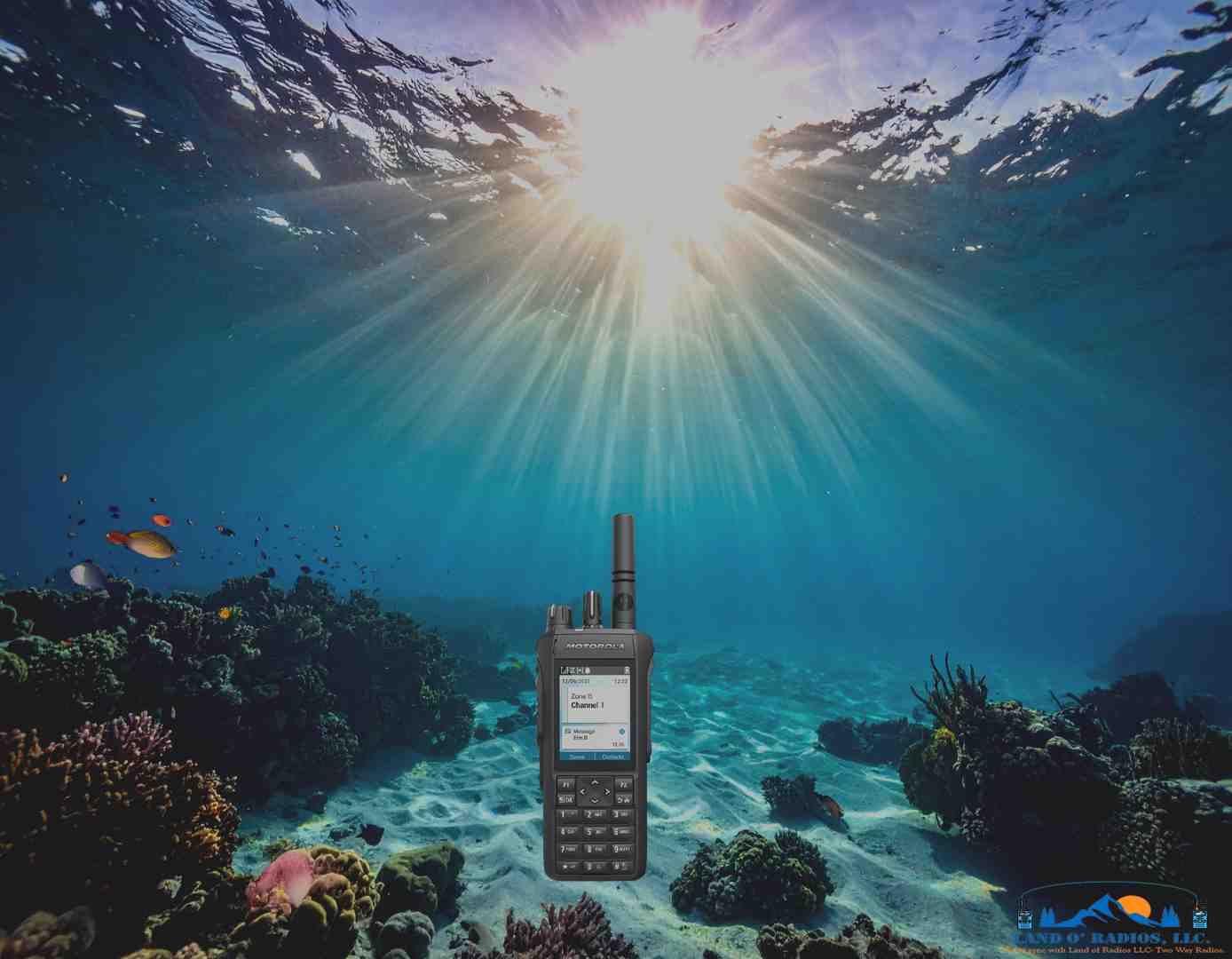
Construction, manufacturing, and emergency response teams choose the R7 when communication failure isn't an option. The radio's Military 810 testing ensures it survives drops, vibration, and extreme temperatures beyond what IP68 water protection covers.
Advanced features include man-down alerts, lone worker monitoring, and emergency signaling that automatically transmits location data. The R7 integrates with Motorola's MOTOTRBO system for wide-area coverage and sophisticated fleet management capabilities.
Picking the Best Fit: Use Cases, Features & Accessories
Selecting the right motorola waterproof radio (ip rated) depends on matching IP protection levels to your specific environment and operational needs. We've found that most buyers either under-specify (choosing IP54 when they need IP67) or over-specify (paying for IP68 when IP67 suffices).
Outdoor recreation typically requires IP67 protection for activities like kayaking, fishing, and snow sports where accidental submersion is possible. Marine environments demand floating capability and water-activated features. Construction sites need dust protection and impact resistance more than deep submersion capability.
Range requirements vary dramatically by application. FRS radios work well for close-team coordination (up to 2 miles in typical conditions), while GMRS and business radios extend range through higher power and repeater compatibility.
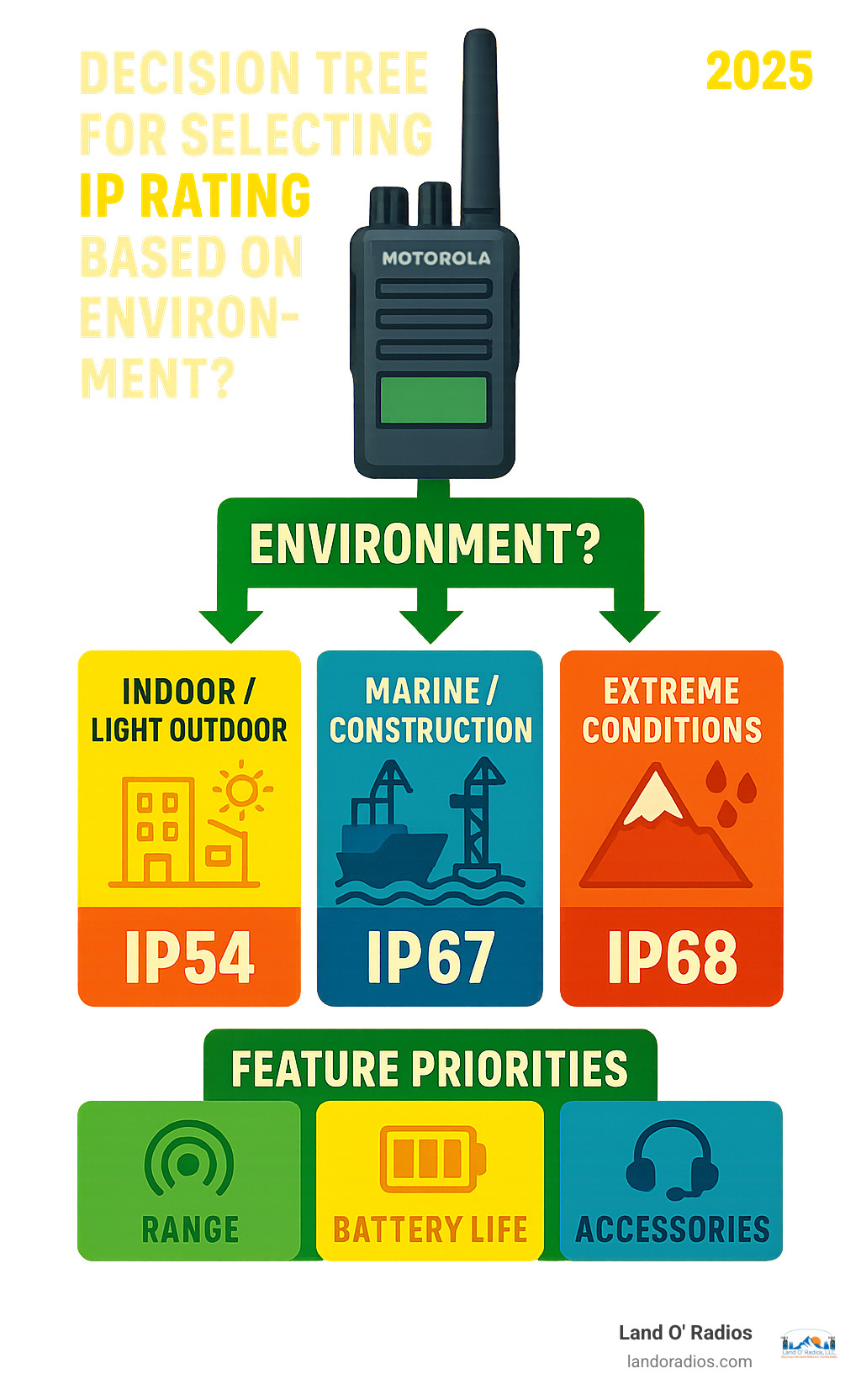
NOAA weather alerts add significant value for outdoor activities, providing automatic severe weather warnings even when you're not actively monitoring the radio. Emergency alert features can transmit distress signals to other radios in your group, potentially saving lives during accidents or emergencies.
Industrial & Harsh-Duty Applications
Construction sites, manufacturing plants, and industrial facilities create challenging environments with dust, moisture, noise, and impact risks. Professional motorola waterproof radio (ip rated) models like the XPR series, R2 and R7 handle these conditions with improved sealing and robust construction.
Dusty environments require IP67 or IP68 protection to prevent particle ingress that could damage internal components. The XPR3300e and XPR3500e provide complete dust-tight sealing while maintaining clear audio quality even in high-noise environments.
IMPRES battery technology extends operation time significantly in professional applications. The R7 achieves up to 29 hours with high-capacity batteries, while standard models typically provide 12-18 hours. This extended runtime reduces battery changes and ensures communication availability during long shifts.
Noise cancellation becomes critical in industrial settings where heavy equipment creates constant background noise. Digital radios like the XPR series provide superior audio clarity compared to analog models, making communication possible even in extremely noisy environments.
Intrinsically safe versions of some models meet requirements for hazardous environments where standard electronics could create ignition risks. These specialized radios undergo additional testing and certification for use around flammable gases or explosive materials.
Must-Have Accessories to Maximize Waterproof Performance
Accessories can compromise IP protection if they're not properly rated and sealed. We recommend using IP57-rated remote speaker microphones with waterproof radios to maintain protection levels at connection points.
Sealed speaker microphones allow hands-free operation while preserving waterproof integrity. The connection point between radio and accessory often becomes the weakest link in water protection, so matching IP ratings across all components is essential.
Spare battery packs extend operational time, but charging systems must also maintain waterproof sealing. The BPR50DX USB-C charging port includes a protective cover that must be properly sealed after each charging session. Car chargers and desktop chargers should be used in dry environments only.
Carry cases and holsters protect against impact while maintaining access to controls and display. However, cases that completely enclose the radio may interfere with heat dissipation and antenna performance. We recommend cases that protect critical areas while allowing normal operation.
More info about two-way vs. walkie talkies can help you understand the broader category differences and accessory compatibility between consumer and professional models.
Buying Tips, Warranty & Support
Motorola waterproof radio (ip rated) purchases represent significant investments, especially for professional models, so understanding warranty coverage and support options protects your investment. Consumer models typically include 1-year warranties, while professional radios often provide 2-3 year coverage.
Warranty terms vary significantly between consumer and professional models. The Talkabout T600 includes a standard 1-year warranty covering manufacturing defects but not water damage from exceeding IP67 limits. Professional radios like the R7 often include 3-year warranties with more comprehensive coverage.
Service plans and extended warranties can provide additional protection, especially for fleets of radios used in demanding environments. Some plans include firmware updates, programming support, and expedited repair services that minimize downtime.
Programming support becomes important for professional models with complex channel configurations and advanced features. Many dealers offer programming services, but some users prefer to handle programming in-house with appropriate software and cables.
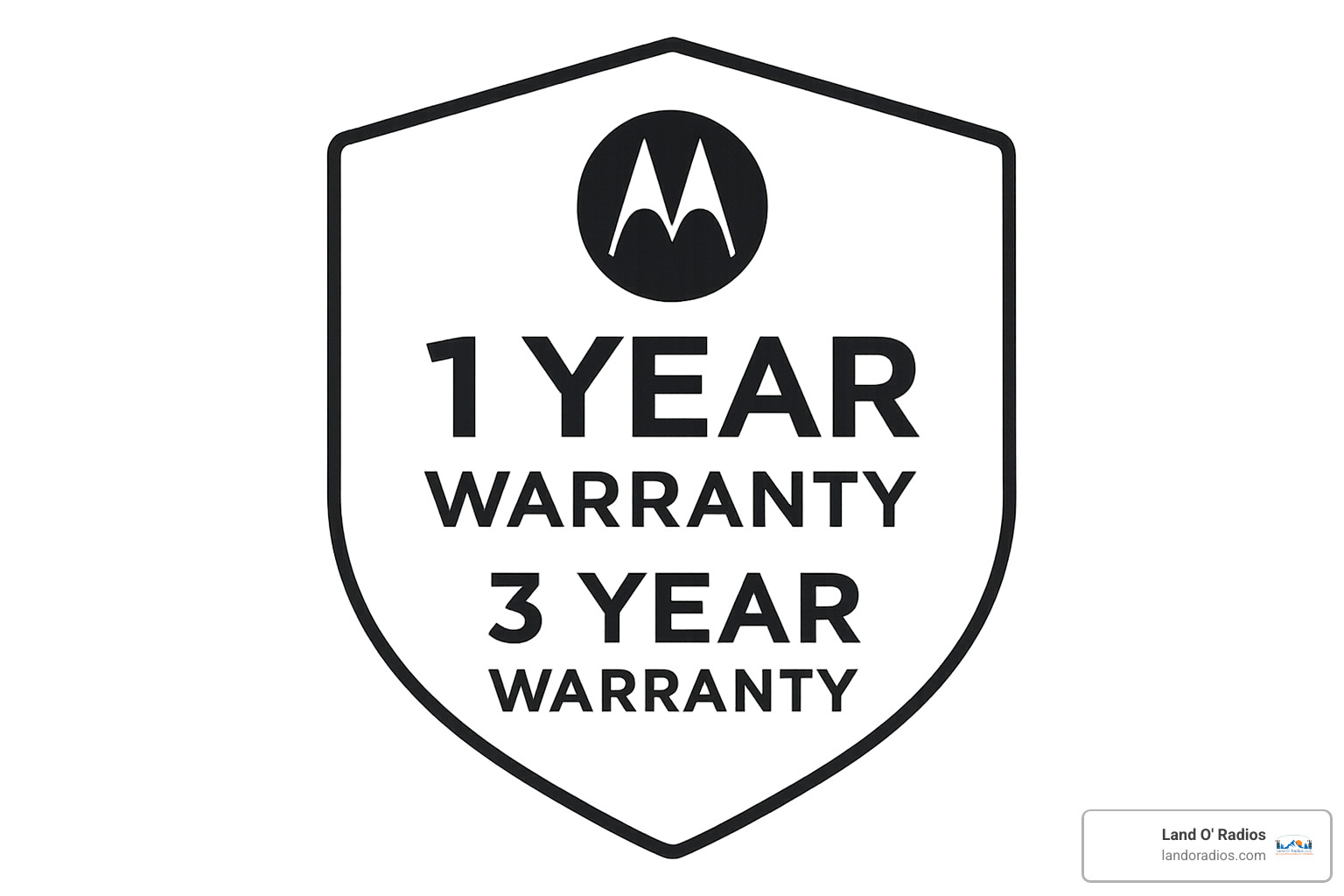
Checklist Before You Buy a Motorola Waterproof Radio (IP Rated)
Environment Assessment:
- What's the maximum water depth you might encounter?
- Are you dealing with freshwater, saltwater, or chemicals?
- How much dust or debris exposure is expected?
- What temperature ranges will the radio experience?
IP Level Requirements:
- IP54: Water spray protection, limited dust resistance
- IP67: 1-meter submersion for 30 minutes, dust-tight
- IP68: 2-meter submersion for 2 hours, dust-tight
Operational Needs:
- How many channels do you need?
- What's your required communication range?
- Do you need hands-free (VOX) operation?
- Are emergency features important?
Power Requirements:
- How long do you need the radio to operate between charges?
- Do you need dual power options (rechargeable and alkaline)?
- Are spare batteries and chargers readily available?
Accessory Ecosystem:
- Do you need remote speaker microphones?
- Are earpieces or headsets required?
- What mounting or carrying options do you need?
Support Network:
- Is local programming support available?
- What's the warranty coverage and terms?
- Are replacement parts and accessories readily available?
Frequently Asked Questions About Motorola Waterproof Radio (IP Rated)
What's the difference between IP67 and IP68 in real-world use?
IP67 allows submersion up to 1 meter for 30 minutes, while IP68 extends that to 2 meters for 2 hours. In practical terms, IP67 handles accidental drops in water, rain, and most outdoor activities. IP68 is designed for intentional underwater use, flood response, and extreme marine conditions.
The pressure difference matters significantly. At 2 meters depth, water pressure doubles compared to 1 meter, requiring much stronger sealing and internal pressure resistance. Most users find IP67 sufficient for typical outdoor and marine activities, while IP68 is essential for professional underwater work or extreme conditions.
Cost differences are substantial—IP68 radios like the R7 cost significantly more than IP67 models. Unless you specifically need the deeper submersion capability, IP67 provides excellent protection for most applications.
Do I need a license to operate these IP-rated Motorola radios?
FRS (Family Radio Service) operation requires no license for radios operating at 2 watts or less on designated frequencies.
GMRS (General Mobile Radio Service) requires a $35 license valid for 10 years, but allows higher power operation and repeater access. Some consumer radios can operate on GMRS frequencies with appropriate licensing.
Professional radios like the XPR series and R7 typically require business radio licenses that vary by frequency band and geographic area. These licenses involve coordination with other users and may require professional assistance to obtain.
Amateur (HAM) radio operation requires passing an exam but provides access to much wider frequency ranges and higher power levels. Some Motorola radios can be programmed for amateur use with appropriate licensing.
Conclusion
Choosing the right motorola waterproof radio (ip rated) means matching IP protection levels to your specific environment and operational needs. Whether you need IP54 water spray protection for basic outdoor work or IP68 submersion capability for extreme conditions, Motorola's lineup provides options for every application.
The key is understanding that IP ratings represent tested, verified protection levels—not marketing claims. An IP67 radio will survive 1-meter submersion for 30 minutes, while IP68 handles 2 meters for 2 hours. Match these capabilities to your worst-case scenarios, not your typical conditions.
Accessories can compromise waterproof protection if they're not properly rated and sealed. Use IP-rated speaker microphones, protect charging ports, and maintain seals according to manufacturer recommendations to ensure long-term reliability.
Water damage remains the leading cause of two-way radio failure, but proper IP-rated protection eliminates this risk. Whether you're coordinating construction crews, managing outdoor events, or staying connected during marine activities, motorola waterproof radio (ip rated) models keep your team communicating when standard electronics would fail.
Stay dry, stay connected, and choose the IP protection level that matches your environment. Your team's safety and operational success depend on reliable communication, especially when conditions get challenging.
More info about smart communications can help you understand how waterproof radios integrate with broader communication systems and safety initiatives.








